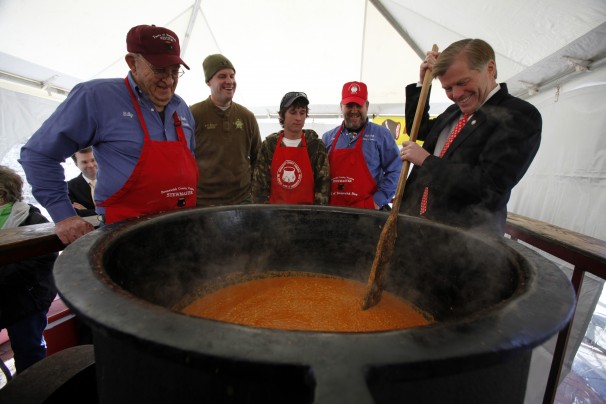 When I arrive around 8:30 a.m. on a brilliant blue winter day in the south-central Virginia town of Alberta (population about 300) to suss out the mysteries of Brunswick stew, I find four guys standing around an 85-gallon cast-iron stew pot, steam rising from its contents of chicken and water, the stew's first stage.
When I arrive around 8:30 a.m. on a brilliant blue winter day in the south-central Virginia town of Alberta (population about 300) to suss out the mysteries of Brunswick stew, I find four guys standing around an 85-gallon cast-iron stew pot, steam rising from its contents of chicken and water, the stew's first stage.
"What time did you start?" I ask.
The crew leader, George Daniel, a mustachioed, white-haired 73-year-old auctioneer in a faded zip-up jumpsuit, takes the opportunity to school me in the long, involved process. "Started yesterday," he says.
"Yesterday?" I ask, confused.
"Billy here was cuttin' potatoes and onions."
That would be Billy Waller, 76, retired from the Virginia Department of Transportation. A solidly built man in a red gimme cap, blue button-down and jeans, Waller is using a long-handled paddle to stir 160 pounds of skinless, boneless chicken thighs in 18 gallons of well water, turning the liquid at the bottom of the pot milky. "We cut a few," he says dryly.
Daniel and Waller are sort of the Lennon and McCartney of Virginia Brunswick stew. The two have cooked together for so many years, they've lost count. They agree that I can say "over 20." Their team, the Red Oak Stew Crew, has won first place in the Brunswick stew competition at the annual A Taste of Brunswick festival in October so often that they've lost count of that number, too.
Their victories have earned them repeated trips to the state capital in Richmond to cook the concoction on the fourth Wednesday in January, a.k.a. Brunswick Stew Day. Virginia's General Assembly approved the designation in 2002. It followed a 1988 resolution proclaiming Brunswick County "The Original Home of Brunswick Stew," a rebuke to the town of Brunswick, Ga., whose state legislature has also issued a proclamation claiming the stew was developed there.
Georgians point to a plaque on a 25-gallon stew pot on St. Simons Island, just outside the town of Brunswick, used in 1898, to support their claim. Virginians say the stew was created in 1828 by Jimmy Matthews, a slave who slow-cooked squirrel, bread crumbs, onions, butter and seasonings for the hunting party of his master, Creed Haskins. In "Southern Food," John Egerton theorizes that the stew was probably being made by American Indians before either of the two states were even colonies.
Whatever the case, the squirrel has long since been replaced with chicken and, especially in Georgia, other meats, most often pork. It has taken on additional vegetables, typically tomatoes, small butter beans and corn, with the Georgians commonly adding peas. Some stew masters still cook over a wood fire to impart a smoky flavor. Most of them, though, use more manageable propane-fueled gas flames. Smoked meats are sometimes added, and the spiciness level, while occasionally fiery, is usually piquant.
I first tasted Brunswick stew in Atlanta in 1988 and have tried numerous versions throughout the South ever since. But there are so many variations that the more I researched the stew, the less I understood it. That's why I headed to Brunswick County for a closer look.
The differences somehow don't obscure the basic identity of the stew, which is thick in texture and umber in color. It is often made as part of a community event, as Daniel and Waller are doing on this particular day in Alberta, cooking as a fundraiser for a church's mission trip to Nicaragua.
Waller takes turns stirring with two younger men: Michael Grimm, 29, Daniel's son-in-law, and Scott Brandt, 47, a five-year team helper who says he is still apprenticing. The four began cooking at 7:45 a.m.
Around 9:30 a.m., Daniel, using an old metal colander, scoops the 100 pounds of sliced onions from a gigantic cooler and adds them to the pot. He does the same with 100 pounds of steak-fry-cut potatoes, submerged in water that is brownish from seasonings. I ask Daniel about the flavorings in the cooler's water. "That," he says with a slight smile, "I can't tell you." A stew master must have his secrets.
Enormous clouds of steam billow up from the pot, enshrouding Waller, who, after being spelled by the others, has taken back the paddle. The process of making the stew is not only long but arduous. I know, because I ask to stir the pot. Daniel acquiesces. The others note that it is a high honor to be allowed. I move the paddle around with effort, trying hard to find a rhythm that doesn't strain my shoulder muscles and keeps my hands away from the pot's scorching-hot rim, all the while tending to my primary responsibility: keeping the stew from burning on the bottom. After a little while, Waller takes over. He has detected a problem. "Clumping up," he says. His tone suggests simple observation, not judgment (I think).
Ingredients are added at intervals. Numerous huge cans of butter beans around 10:15, giant cans of crushed tomatoes at 10:35, big cans of two kinds of corn — cream-style and shoe peg — sometime after noon. Throughout the latter stages, Daniel shakes immeasurable quantities of salt, black pepper and cayenne into the pot. Every so often, team members spoon stew into small plastic-foam cups to taste for flavor. More salt is added. More pepper. More cayenne.
Waller places the paddle in the middle of the pot and it doesn't budge. "The stew is done when the paddle stands up," Daniel says.
Rumor has it that there is a notch in the bottom of the giant stew pot that the paddle fits into. Daniel is tight-lipped about that. Part of the appeal of Brunswick stew, he understands, is its mystique.
When the stew is finally finished, I try a little bit in a foam cup. It's coral in hue and velvety in texture, thick with strands of chicken, studded with butter beans, kernels of corn and pieces of undissolved potato. The slow, long, lazy bubbling of tomatoes and chicken and vegetables has created a mild flavor, the cayenne a gentle sting.
Throughout the morning, townsfolk have dropped by to ask when the stew will be ready. They have been smelling it all the way down the block. Daniel and Waller cook community stews twice, sometimes three times a month. Since news of this stewmaking was announced weeks ago (by old-fashioned word of mouth; no social media here), locals and even Richmond residents an hour away have ordered multiple quarts. For days, every ounce of the 85 gallons has been spoken for. In fact, it's over-sold. Daniel starts calling around to see who might reduce their order.
Around 1:30, people start coming by for their quarts. This one gets six, that one 10, another 22, at $7 per quart. I hadn't known the etiquette about ordering in advance. I am fearful I won't get any.
Daniel has already considered that. He pours stew from the pot into a plastic quart container. "You know what you watched today?" he says.
"Yeah?"
He smiles mischievously.
"You didn't see everything," he says.
He hands me a quart, and I head back to the Big City, believing I know more than I probably do.
By Jim Shahin, from The Washington Post
